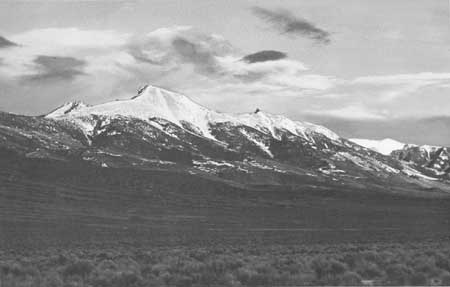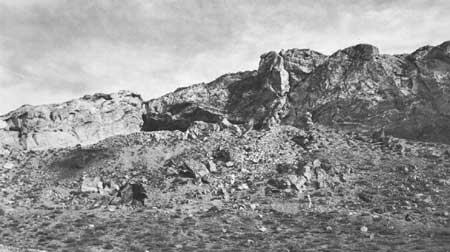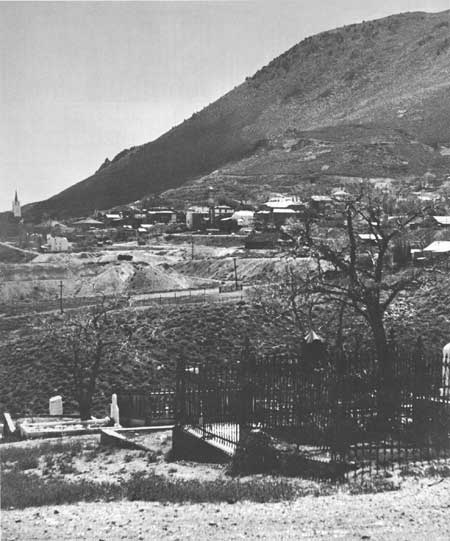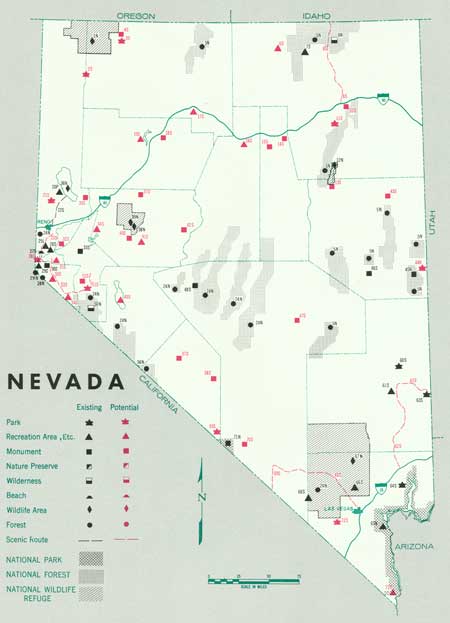.gif)
Parks for America
MENU
|
Parks for America
|

|

|
| At Wheeler Peak in Nevada, one can climb from desert to alpine environment. An excellent example of the Great Basin physiographic region, the area has been recommended for establishment as Great Basin National Park. (ERWIN FEHR.) |
NEVADA
NEVADA is located in the Great Basin region. Its population increased 78 percent between 1950 and 1960 to 285,278. Projections indicate it may be 523,000 by 1976. In 1960, 70 percent of the people lived in urban areas with ample open space around them, as there were less than 3 people per square mile in the State.
Tourism, which revolves mainly around gaming, is the leading industry, with total 1958 expenditures of $440 million by out-of-State visitors. Agriculture, mining, and transportation make up the balance of the State economy.
A well-developed highway system gives access to all but the remote interior parts of the State. Due to great distances between centers of interest, intrastate air transportation is of some importance.
Nevada has great space. The scenery ranges from desert expanses with colorful mountains to high forested ranges. The Colorado River with the Lake Mead Reservoir, Lake Tahoe in the High Sierra, and Pyramid Lake are important water features. Wilderness values are high, and wildlife values consist primarily of upland game birds and major big game species which provide excellent hunting.
Warm- and cold-water fishing is available. Mild winters in the southern part of the State are conducive to year-round outdoor recreation.
The State has a number of important historic sites and significant paleontologic and archeologic areas. Fort Churchill, Fort Ruby, Virginia City, and Leonard Rock Shelter possess exceptional value in commemorating the history of the United States.

|
| Lovelock cave near Humboldt Lake, Nevada, yielded an array of important ancient Indian artifacts. |
EXISTING PUBLIC AREAS
NATIONAL: The National Park Service administers two national monuments and one national recreation area with a Nevada acreage of 805,707 acres. The 1960 attendance was 2,630,700. There are 4 national forests totaling 5,058,027 acres administered by the Forest Service, including 30 recreation areas with 1,600 acres, and a wild area and a natural area, with 67,063 acres. The Bureau of Sport Fisheries and Wild life manages seven national wildlife refuges and game ranges containing 2,854,301 acres. The Bureau of Land Management has set aside two recreation areas of 77,480 acres.
STATE: The State Park Commission administers four monuments, three parks, one recreation area, and one beach with a total of 9,864 acres. The 1960 attendance was 156,000. In addition, it administers five recreation areas on lands in other ownership. The State manages 250,357 acres of game land which is subject to hunting.
LOCAL: The Washoe County Park Commission has a 46-acre historic monument-recreation area and a 28-mile scenic route.
PRIVATE ENTERPRISE: Private enterprise provides significant outdoor recreation facilities in dude ranches and at water areas.
PARK AND RELATED NEEDS
There is an existing and growing need for close-in, day-use facilities in the Reno area. Water-oriented recreation outlets are in short supply. Existing park and recreation areas need greater development. Official designation and protection of scenic routes are needed. There is need for greater attention to archeologic and other scientific values with which the State is well endowed. The State park system is substantially organized, but might be strengthened by a greater diversity in types of areas. The 103,470 acres of potential major local areas identified in this plan, if acquired, should meet the additional 1976 needs and provide balance.

|
| Virginia City, Nevada, the historic mining center where the Comstock Lode bought a bonanza in silver. |
RECOMMENDATIONS
Existing recreation resources and many potential areas are shown on the accompanying tabulation and map. The following recommendations are made to help provide needed outdoor recreation opportunities for public enjoyment and use.
NATIONAL: Establishment of Great Basin National Park.
STATE: Expansion of the State park system by the addition of 5 parks, 10 recreation areas, 2 scientific monuments, and 5 historic monuments, and further study on 3 parks, 1 recreation area, 6 scientific monuments, and 4 historic monuments. Designation and protection of five scenic roads.
Supporting recommendations include
1. Development of additional waysides on main routes of tourist travel with emphasis on related historic features.
2. Field investigations to determine the potentialities of the Red Rock Canyon and Pyramid Lake vicinities.
(Table omitted from online edition)

|
| (click on image for an enlargement in a new window) |
NEXT >>>
|
|
Last Modified: Mon, Sep 6 2004 10:00:00 pm PDT
parks_america/nevada.htm
 Top
Top